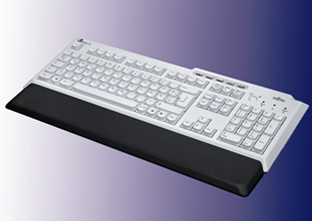
Bio-based plastics at the crossroads
There are two main ways to develop bio-based plastics: one is by making familiar polymers from the same molecules derived, not from oil, but from agriculture, like polyethylene made from agricultural ethylene. The other is to create new polymers from new agriculture-derived molecules, like PLA made from lactic acid.
Never change a winning team
Fossil-based 'traditional' plastics can therefore also be produced from biomass. Indistinguishable from their oil-based identical twins, and with all their winning properties, they can also be recycled through existing processing industry facilities. To some extend, consumer plastics are bio-based, like PET (polyethylene terephthalate) used for bottles and fleece, and PE (polyethylene) of supermarket bags. Polyvinyl chloride (PVC) (Solvay) and polypropylene (PP) (Braskem) projects will soon be coming into the pipeline. But they are also moving into the so-called engineering plastics, like PEX (cross-linked polyethylene) for cable sheaths and even UHMWPE (ultra high molecular weight polyethylene) used for sports equipment, protective equipment and surgical implants, PA (polyamides) and more.

Traditional bio-based plastics attack the market
 Toyota Motor Corporation has announced plans to start using partly bio-based polyethylene terephthalate (PET) in vehicle trims, in 2011. The Bio-PET developed by Toyota Tsuho is to replace the 30% fossil-based ethylene glycol in PET with an identical monomer derived from sugar cane processing.
In the beverage industry, Coca-Cola had already set things moving with its "PlantBottle", 22.5% composed of partly plant-derived PET plastic. The Danone Group followed suit in 2010 with its Volvic bottles 75% composed of partly bio-based PET and 25% of recycled PET (PETr)..
Toyota Motor Corporation has announced plans to start using partly bio-based polyethylene terephthalate (PET) in vehicle trims, in 2011. The Bio-PET developed by Toyota Tsuho is to replace the 30% fossil-based ethylene glycol in PET with an identical monomer derived from sugar cane processing.
In the beverage industry, Coca-Cola had already set things moving with its "PlantBottle", 22.5% composed of partly plant-derived PET plastic. The Danone Group followed suit in 2010 with its Volvic bottles 75% composed of partly bio-based PET and 25% of recycled PET (PETr)..
 In 2008, the Spanish group Merquinsa launched a new range of polyurethanes derived from renewable materials, adding to the bio-based polyesters and polyethers already used in sports shoe, electronic equipment and car manufacture.
Ford already uses 12% of soy in its foams, aiming for 25% and is already using the replacement strategy as part of its sales pitch.
In 2008, the Spanish group Merquinsa launched a new range of polyurethanes derived from renewable materials, adding to the bio-based polyesters and polyethers already used in sports shoe, electronic equipment and car manufacture.
Ford already uses 12% of soy in its foams, aiming for 25% and is already using the replacement strategy as part of its sales pitch.
An evergreen polyamide, 60 years young
 he French chemicals company Arkema broke new ground with its Rilsan. This castor oil-derived polyamide in manufacture since 1950 has long been turned to for its high technical performance in such things as car engine parts.
The renewed interest in bio-based plastics has now put it centre stage.
he French chemicals company Arkema broke new ground with its Rilsan. This castor oil-derived polyamide in manufacture since 1950 has long been turned to for its high technical performance in such things as car engine parts.
The renewed interest in bio-based plastics has now put it centre stage.
The new "bio-based plastics": youthful can-do
The "new" bio-based plastics are made from new molecules which are in turn derived from agrochemicals. Researchers are working hard to turn to materials that occur in fields and forests (starch, xylan and mannan from seeds, cellulose and lignin...), and in the sea (chitin from crustacean shells, polymers from algae). This research is leading to new extraction methods, one of the most innovative being "clean room biotechnology" based on the action of bacteria, enzymes and even fungi that are capable of "synthesising" biopolymers.

L'amidon Providentiel
 Starch can be used in two ways. One is to produce polylactic acid (PLA) from maize fermentation. Thomas Lefèvre, Manager of Natureplast, says "Demand is now growing for PLA which is more economical, as well as being transparent and well suited to thermoforming, injection moulding, die moulding and blow moulding."
It can also be used “as is” or mixed with polyesters to give it useful properties like permeability and greater mechanical strength.
Starch can be used in two ways. One is to produce polylactic acid (PLA) from maize fermentation. Thomas Lefèvre, Manager of Natureplast, says "Demand is now growing for PLA which is more economical, as well as being transparent and well suited to thermoforming, injection moulding, die moulding and blow moulding."
It can also be used “as is” or mixed with polyesters to give it useful properties like permeability and greater mechanical strength.
The future is an open door
 The "new" biosourced plastics bring new qualities and, like any innovation, are working hard to capture their place in the market alongside 'traditional' polymers.
Whether new or traditional, bio-based plastics hold out promising prospects as a supplement to fossil resources. But even then, the environmental benefit has to be assessed in each case using methods like Life Cycle Assessment.
The "new" biosourced plastics bring new qualities and, like any innovation, are working hard to capture their place in the market alongside 'traditional' polymers.
Whether new or traditional, bio-based plastics hold out promising prospects as a supplement to fossil resources. But even then, the environmental benefit has to be assessed in each case using methods like Life Cycle Assessment.





